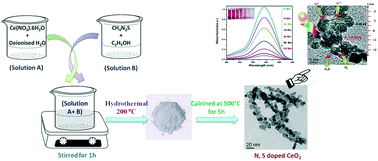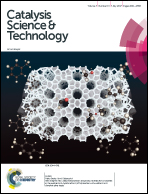Enhanced visible light harnessing and oxygen vacancy promoted N, S co-doped CeO2 nanoparticle: a challenging photocatalyst for Cr(vi) reduction†
Abstract
Nanoceria and its derivatives are promising photocatalysts for environmental sustainability due to their strong redox ability, high oxygen storage/release capacity, eco-friendly nature, photostability and cost effectiveness. This study highlights the first time N/S co-doped ceria prepared using a simple hydrothermal method from a Ce(NO)3 and thiourea source. The spectrographic, crystallographic and macroscopic features of the as-synthesised photocatalysts were characterised by TEM, DRUV-vis, PL, TRPL, XRD, Raman and photoelectrochemical measurements. Under visible light illumination, doped ceria exhibits remarkable photocatalytic activity towards Cr(VI) reduction, in contrast to neat CeO2. The enhanced photoreduction ability of doped species, particularly 36 h treated samples (NCS-36), is due to more light absorption capacity, greater photocurrent generation and high concentration of photoexcited electrons, which were well supported by characterization techniques. The average lifetime decay of photoexcited electrons and the photocurrent density of NCS-36 were found to be 75.37 ps and 3.87 mA cm−2, which is nearly 3- and 12-times higher than that of neat ceria, respectively. These obtained results clearly explain the 93% photoreduction ability of NCS-36 towards a 50 ppm Cr(VI) solution within a time span of 120 min under visible light irradiation.



 Please wait while we load your content...
Please wait while we load your content...